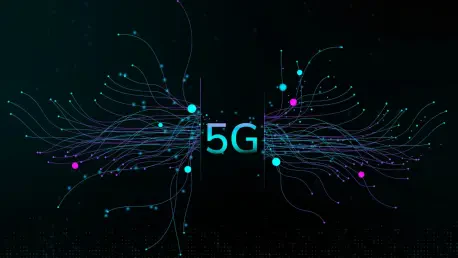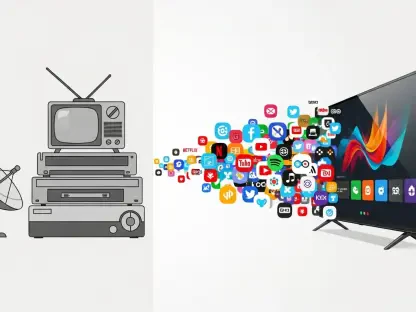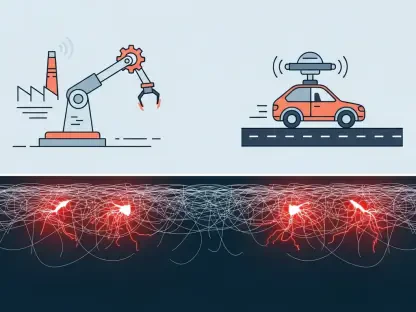The telecommunications industry stands at a pivotal moment, where the urgent need for scalability, efficiency, and innovative service delivery compels operators to move away from outdated, siloed systems toward AI-driven, autonomous networks. This shift is not just a distant goal but a pressing necessity to meet rising customer expectations and competitive pressures. At the heart of this transformation are two key concepts: topology, which maps the intricate interconnections and dependencies within a network, and ontology, which provides a structured way to interpret and analyze vast data sets. Highlighted by industry pioneers at Ericsson’s OSS BSS Summit in London, these concepts are set to redefine how telecom networks operate, enabling real-time responsiveness and intelligent automation. Insights from leading operators such as Orange, Telstra, Deutsche Telekom, and BT, alongside Ericsson’s strategic vision, offer a clear view of a future where networks don’t merely react but anticipate and adapt on their own. However, the journey ahead is fraught with challenges, from handling massive data volumes to building trust in AI-driven decisions. This exploration examines how these foundational ideas are guiding the industry into a revolutionary era of connectivity and service innovation, laying the groundwork for a deeper look at the obstacles and solutions that lie ahead.
Envisioning the Autonomous Network Era
The consensus among telecom leaders is clear: autonomous networks are the inevitable future of the industry. These systems, built to self-manage through advanced closed-loop automation, are essential for delivering customized services while meeting strict Service Level Agreements (SLAs). Ericsson’s Mats Karlsson emphasizes that full automation is not an option but a necessity to translate high-level business goals into concrete network actions with minimal human intervention. This vision promises a landscape where networks dynamically adapt to demands, ensuring both operational efficiency and customer satisfaction. The push toward autonomy is driven by the need to innovate quickly and maintain a competitive edge in an increasingly crowded market, positioning telecom companies to redefine service delivery standards.
A critical component in achieving this vision is the use of digital twins—real-time virtual replicas of physical networks. These models allow operators to simulate changes and predict outcomes before applying them in live environments, thereby avoiding potential conflicts or service disruptions. By offering a safe testing ground, digital twins help balance complex resource allocations and maintain service quality, especially as network complexity increases. This technology is not just a tool but a foundation for creating smarter, more adaptive systems that can anticipate issues and optimize performance, marking a major step toward the autonomous ideal that industry leaders aim to realize.
Confronting the Data Deluge and Observability Gap
One of the most daunting challenges telecom companies face is the immense volume of data generated daily, often measured in petabytes, along with millions of system alerts. As Orange’s Houda Mansour points out, this data is often scattered across isolated systems, creating a barrier to achieving a unified, real-time view of network operations. Known as observability, this comprehensive perspective is crucial for effective automation, yet it remains out of reach for many operators. The inability to integrate disparate data streams hinders the ability to respond quickly to issues or predict problems, slowing progress toward intelligent network management. Closing this gap is essential to unlocking the full potential of autonomous systems, requiring innovative approaches to data integration and analysis.
Compounding the problem is the diversity and structure of the data itself, which varies widely across different platforms and legacy systems. Without a streamlined way to consolidate and interpret this information, telecom companies risk being overwhelmed by noise rather than gaining actionable insights. The push for observability demands not only technological solutions but also a cultural shift within organizations to prioritize data accessibility and clarity. Concepts like data democracy—where information is unified and accessible across systems—are gaining traction as vital strategies. Only by overcoming these data-related obstacles can the industry advance toward networks that operate with the precision and foresight needed for the future.
Mapping the Network with Topological Insights
Topology serves as a crucial framework for understanding the complex web of a network’s nodes, connections, and interdependencies. By offering an end-to-end view, it enables telecom companies to pinpoint the root causes of operational issues and predict the ripple effects of changes across various services and domains. This structural clarity is essential for ensuring that automation does not unintentionally disrupt critical functions or compromise service integrity. As networks become more complex with the integration of new technologies, having a detailed topological map becomes a cornerstone for maintaining stability and enabling proactive management in an era of constant change.
Beyond troubleshooting, topology acts as the foundation for strategic planning and resource optimization within telecom infrastructures. It equips operators with the ability to see dependencies that might otherwise remain hidden, supporting more informed decision-making. For example, understanding how a single change in one area can affect multiple services allows for better coordination and risk mitigation. As the industry moves toward greater automation, the role of topology in providing a reliable blueprint cannot be overstated. It ensures that every automated action is based on a thorough understanding of the network’s architecture, paving the way for seamless operations and improved service reliability.
Interpreting Data through Ontological Frameworks
While topology maps the physical and logical structure of networks, ontology adds depth by providing a structured approach to interpret raw data. Described by Telstra’s Mark Sanders as a “Knowledge Plane,” ontology turns disparate data points into meaningful insights, enabling AI systems to make informed decisions. This framework unites fragmented systems under a shared understanding, bridging gaps between diverse operational platforms. By explaining the “why” and “how” behind network events, ontology enhances automation by ensuring actions align with broader business goals and operational limits, marking a significant advance toward intelligent systems.
The strength of ontology lies in its ability to transform data from mere information into actionable knowledge, a shift that is critical for the next generation of telecom networks. It allows AI to operate within a trusted context, reducing the risk of incorrect decisions that could disrupt services. Additionally, ontology promotes interoperability among systems that might otherwise remain isolated, creating a unified environment where insights can be shared and acted upon efficiently. As telecom companies face increasingly complex data landscapes, adopting ontological frameworks offers a way to manage this complexity, turning it into a competitive advantage through smarter, more responsive network management.
Navigating AI Integration and Trust Issues
Artificial Intelligence, particularly agentic systems capable of independent observation, decision-making, and action, is a cornerstone of future telecom networks. These systems promise to drive closed-loop automation, reducing human intervention and speeding up response times. However, as Telstra’s Mark Sanders notes, a major barrier remains in the form of trust. Many in the industry are hesitant to relinquish control to AI without strong proof of reliability, especially for critical operations. This caution highlights the need for thorough testing and validation to ensure AI decisions consistently align with operational and business goals.
There is also a growing focus on developing user-friendly human interfaces to complement AI systems, with generative AI showing potential to simplify complex interactions. Such interfaces aim to make automation accessible to a wider range of stakeholders, ensuring that even as networks become more autonomous, human oversight remains effective and informed. Balancing AI autonomy with accountability is a delicate task, requiring clear guidelines and transparency to build confidence among operators. As the industry moves forward, addressing these trust concerns will be crucial to fully integrating AI into the fabric of telecom networks, enabling a smooth transition to self-managing systems.
Adapting to Operational Transformations
The shift toward horizontal digital architectures, as seen with Deutsche Telekom, introduces new operational dynamics for telecom companies. While these setups simplify certain aspects of network management by reducing the complexity of multiple service chains, they also complicate accountability and fault detection. A single infrastructure change can impact numerous services, making it difficult to identify responsibility or the source of issues. Real-time data correlation, supported by strong topology and ontology frameworks, becomes essential in navigating these challenges, ensuring transparency and maintaining service continuity amid evolving structures.
This operational transformation underscores the urgent need for improved observability and data integration to manage the interdependencies inherent in modern architectures. Without a clear, real-time understanding of network interactions, telecom companies risk delays in resolving issues and potential service degradation. The adoption of centralized data solutions, such as lakehouses for unified storage and processing, is emerging as a practical response to these challenges. By leveraging such tools alongside topological mapping and ontological reasoning, operators can better adapt to the complexities of horizontal systems, ensuring that innovation in architecture leads to real improvements in performance and reliability.
Pioneering the Path Forward
Reflecting on discussions from industry leaders, it’s clear that the telecom sector has undergone a profound shift in focus, prioritizing autonomous networks as the foundation for future growth. Operators like Orange, Telstra, Deutsche Telekom, and BT each offered unique perspectives—whether through graph-based topology mappings, knowledge-driven planes, or reimagined OSS/BSS roles as innovation drivers. Their collective insights revealed a shared commitment to overcoming data silos, achieving real-time observability, and embedding AI with trust. Topology and ontology proved to be indispensable, providing the structural and interpretive foundations needed for automation to thrive in a landscape of growing complexity.
Looking ahead, the next steps involve collaborative efforts to bridge existing technological gaps and establish industry-wide standards. Partnerships, potentially facilitated through platforms like TM Forum, will be vital for developing interoperable solutions that no single entity can achieve alone. Investing in centralized data architectures and advancing digital twin capabilities should be prioritized to improve network predictability and control. Furthermore, building trust in AI through transparent validation processes will encourage broader adoption of agentic systems. As these strategies unfold, the telecom industry can turn challenges into opportunities, creating networks that not only meet current demands but also anticipate future needs with unmatched precision and innovation.









